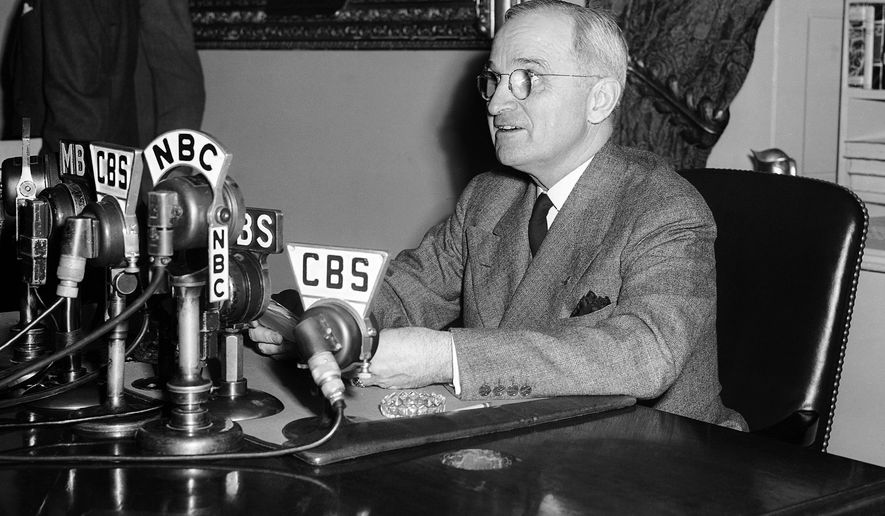JEFFERSON CITY, Mo. (AP) - Harry Truman is headed back to Washington.
A statue of Truman, the nation’s 33rd president who ended World War II after authorizing the use of atomic bombs against Japan, is set to be displayed in the U.S. Capitol next year. Every state gets to choose two statues for the National Statuary Hall Collection, and Missouri has displayed the same two men since the end of the 19th century. Missouri leaders thought it was time that Truman, who they called the most important statesman the state has produced, was represented there.
Alex Burden, the executive director of the Truman Library Institute, said they had raised more than $300,000 to pay for the statue and fielded five artist proposals, four of them from Missouri.
But the choice of which statue Truman should kick out is not clean-cut.
Truman will displace Francis Preston Blair, Jr. or Thomas Hart Benton. Both men were U.S. Senators, war-time soldiers and slavery opponents.
Yet before Benton spoke so stridently against the expansion of slavery that voters kicked him out of Congress, he inherited two slaves. And while Blair was instrumental in keeping Missouri out of the Confederacy, he once campaigned for office on the premise that black people were part of “a semi-barbarous race.”
“Tragically, a controversy has arisen over which of the individuals honored by Missouri represents the greatest level of racism,” U.S. Representative Emanuel Cleaver said in a statement in April.
Cleaver supports kicking out Blair, and years ago Missouri lawmakers approved that swap. A new proposal in the Legislature, however, would instead remove Benton, and for partisan, not racial, reasons.
The question comes amid a national debate over what historical figures should, and should not, be on public display. Confederate statues all over the country have been removed and vandalized.
James Grossman, the executive director of the American Historical Association, said decisions like these matter.
“When a community puts up a statue … there’s a statement of community values,” he said. “Statues are as much a part of public education as schoolrooms.”
In 2002, no one in Missouri’s House or Senate opposed kicking Blair out, and the governor at the time, Democrat Bob Holden, signed off on the change. Truman would stand near Benton, the great-great-uncle of the famous Missouri artist also named “Thomas Hart Benton.”
Then the issue took a partisan turn. Both Truman and Benton were Democrats, which didn’t sit well with some Republicans in Congress.
Last year, all six Republicans representing Missouri in the U.S. House of Representatives sent a letter to Missouri Gov. Eric Greitens asking that he “reconsider” removing Blair, who helped establish the Republican Party in Missouri. Spokespeople for Representatives Sam Graves, Vicky Hartzler and Jason Smith confirmed that the impetus for the letter was keeping the statues bipartisan.
As a result, Republican state Sen. Dan Hegeman introduced a resolution in March to keep Blair, a one-time Republican, and remove Benton, the Democrat.
That prompted pushback from editorials in The Kansas City Star and The Joplin Globe arguing that Blair’s speeches saying that black people were “inferior” made him far worse.
Hegeman acknowledged that both figures had problems. “They were men of their own time,” he said. Blair, however, helped keep Missouri in the Union, he pointed out. That had to count for something.
Both Republicans and Democrats in the Senate agreed with Hegeman’s choice, and on Tuesday voted 32-0 to keep Blair. Missouri’s House still need to sign off on the resolution, and the legislative session ends Friday.
If the new resolution doesn’t pass this year or next, Truman will stand with Benton as planned.
Either way, Truman’s arrival in Washington will present the state with another choice: How to commemorate the returned statue?
If it was up to Grossman, at the American Historical Association, he would put statues of controversial people in museums.
“These are all part of our history, they shouldn’t be destroyed,” he said. “But we can contextualize.”
___
The resolution is SCR 50




Please read our comment policy before commenting.